 |
BREEDS
& THEIR NEEDS
Barrabands
(Superb Parrot)
|
 |
Click
on the pictures to enlarge them then press "Back" to return the
this page
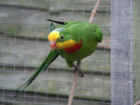 |
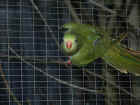 |
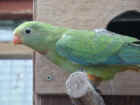 |
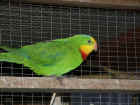 |
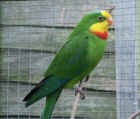 |
|
Mature
Cockbird |
Juvenile
Cockbird |
Young Cock - Red Slash
starting on throat and yellow on top of head in evidence. |
Adult
Cockbird |
Adult
Cockbird |
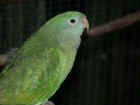 |
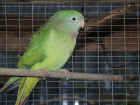 |
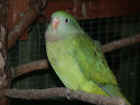 |
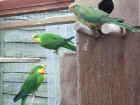 |
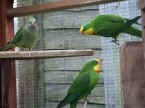 |
|
Mature Hen |
Mature Hen |
Mature Hen |
2 Adult +
young Cockbird |
Adult
Cocks +1 young Hen |
-
Another gentle, quiet,
inoffensive bird that has a pleasant, melodic call, which shouldn't
upset any Neighbours.
-
They originate from
Australia, where they are called the "Superb Parrot".
-
They are very similar to
Kaki's as far as diet and husbandry are concerned.
-
You could in fact, keep
them in a mixed Aviary with Kakis and/or cockatiels etc.
-
They are ideal Aviary
Birds but wouldn't be as happy in a cage as a house Pet.
-
they do need to fly and
therefore need the space a good-sized Aviary would provide.
FEEDING
-
They eat Parakeet Mix. (Not
too many Sunflower seeds - fattening and addictive).
-
They enjoy a variety of
seeds.
-
They love Millet Sprays.
-
They love all the Fruit and
Veg (esp. carrot, apple, celery, broccoli etc.,) that Kakis seem to like
-
+ brown bread, Mtn Ash Berries, Willow &
Eucalyptus branches and all the usual
wild
foods & seeds.
-
They love cooked frozen
Sweet corn mixed with egg food and shredded chicken (at breeding time).
BATHING
AVIARY-LIFE
-
They will mix well with most
other amiable, non-aggressive Aviary Birds.
-
They can be a bit flighty if
there are a few of them and you go in the Aviary with them.
-
They do need a pretty
spacious Aviary - 10ft+ long x 8ft wide minimum,
-
as they need plenty of space to fly.
-
they like branches of all
shapes and size to help keep the muscles in their feet excercised
-
The branches don't have to
be horizontal - after all you don't find all the branches on a tree on a
horizontal plane - so make sure the bird has a good selection.
-
Make sure they also have
very wide perches 3"+
-
Plenty with bark still on
off safe trees, for them to chew
POTENTIAL PROBLEMS
-
They can be prone to upper
respiratory infections, notably mycoplasmosis, which can also
effect the
eyes - so keep watch on them.
-
Also, a clean, non-stuffy
atmosphere with plenty of fresh air but no Draughts is essential.
-
They also love clinging to
the Aviary roof mesh during and after rain showers, to lick the drops
of
rainwater.
-
They remind me of Lorikeets lapping nectar, they way they use
their tongues
to get the droplets.
-
They also, spend time on the
floor foraging, so you must keep on top of
Worming
SEXING BARRABANDS
-
Many breeders have found
that, just as they begin to dream of nesting successes, their
"females" suddenly mature into males.
-
Most young Barrabands tend to
look like "Hens" when they first fledge.
-
The odd one (the exception
rather than the rule) will have a more "yellow" look about the
head
as soon as it fledges and emerges from the Nest box with a
suggestion of the red slash at the
throat, which gets more
pronounced around first juvenile moult (about 6 months).
-
I have just seen 3 babies in
the nest - all with Yellow foreheads - so some chicks you can tell if
they are cock birds that early - it's really the hens that you would have
no indication if they
were going to develop into cock birds until at least the first moult!
-
Many inexperienced
Breeders and owners are often convinced they have young hens and buy or
sell them as such - then they start to colour up between 12 - 18months
and show their true colours!
-
The one in the
picture (3rd from left on top row) above is that exception! (He's one of the few
that showed yellow around the head and the red throat slash, as
soon as he emerged from the nest.
-
Others, (poss. the majority)
however, stay "looking" like a Hen bird until the colour change,
to
confirm they are cock birds.
-
They then usually become sexually active.
-
They will breed from 2yrs
old usually.
-
-
Young cock birds tend to have
brown irises rather than the orange irises adult hens have.
-
Young cock birds start
"singing"/warbling long before they moult into their full adult plumage,
which can be a bit of a give-away as to their true sex.
-
Breeders should purchase
females that are approximately 2 years old to be certain of their sex.
-
The
picture
bottom right
(above) shows 2 mature
cock birds and hopefully, one young
"hen",
that is only 7 months old, so may yet still
mature as a cockbird!!
BREEDING
-
Nest boxes are best if the are
approx. 2ft deep x 12" square.
-
They will breed en-colony -
just make sure you have more Nest boxes than pairs.
-
Also ALL the NESTBOXES are
the same height and very similar or same design.
-
Put a respectable covering
of Easibed substrate into the bottom of the Nest box.
-
If they are bred in separate
Aviaries, try and make sure you house 2 pairs within sight and
sound of each other to increase the likelihood of breeding.
-
Hens can lay eggs at around 1
year old but are usually 2- 3yrs before they are fertile.
-
As per most breeds they need
extra Protein when breeding and feeding chicks.
-
They love
Sweetcorn mixed with EMP Eggfood which can have necessary Vitamin
supplements added to it.
-
Make sure, as with all other
Parakeet-types to provide Cuttlefish bone, grit, iodised Mineral block
(the pink ones), when breeding.
-
These are necessary to
provide some of the Calcium and minerals necessary to form good quality
eggshells and helps prevent the Hen drawing on her own body's Calcium
reserves and depleting them.
-
For a successful breeding
process, maintain slight humidity in the nesting area.
-
They tend usually just to
have ONE clutch of eggs and chicks per season.
-
The parents seem quite
happy to have the fledglings live in the same Aviary with them, even
when they go to nest again the next year.
-
The Hen lays 4 - 6
eggs
-
incubation period of approx. 19 - 20 days.
-
Chicks start to fledge around
40 days.
-
Ring 11 - 13 days Ring size: P
-
An eye should be kept on the
male once the chicks fledge, to be certain he does not become
prematurely aggressive and harm the young in his desire to start a new
nest.
-
Fledglings must also be
watched carefully because their initial attempts to fly can produce
unco-ordinated movements that can result in injury.
-
For this reason, it
is important not to startle
the young birds.
-
This period of clumsiness
generally does not last long, however, and young birds become proficient
flyers after only a few days of effort.
|